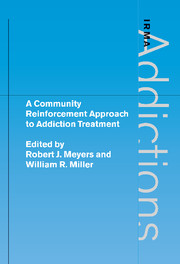Book contents
- Frontmatter
- Contents
- List of contributors
- Preface
- Acknowledgments
- 1 Developing the Community Reinforcement Approach
- 2 Practice and Promise: The Azrin Studies
- 3 The Treatment
- 4 A Comparison of CRA and Traditional Approaches
- 5 Community Reinforcement and Traditional Approaches: Findings of a Controlled Trial
- 6 CRA with the Homeless
- 7 CRA and Treatment of Cocaine and Opioid Dependence
- 8 Community Reinforcement and Family Training (CRAFT)
- 9 Summary and Reflections
- References
- Index
1 - Developing the Community Reinforcement Approach
Published online by Cambridge University Press: 05 August 2012
- Frontmatter
- Contents
- List of contributors
- Preface
- Acknowledgments
- 1 Developing the Community Reinforcement Approach
- 2 Practice and Promise: The Azrin Studies
- 3 The Treatment
- 4 A Comparison of CRA and Traditional Approaches
- 5 Community Reinforcement and Traditional Approaches: Findings of a Controlled Trial
- 6 CRA with the Homeless
- 7 CRA and Treatment of Cocaine and Opioid Dependence
- 8 Community Reinforcement and Family Training (CRAFT)
- 9 Summary and Reflections
- References
- Index
Summary
The story of the Community Reinforcement Approach (CRA) begins 30 years ago, when indigent alcohol-dependent individuals in downstate Illinois were routinely admitted to the nearest state mental hospital. For the 27 southernmost counties in Illinois, this institution was Anna State Hospital. Despite the fact that nonmedical detoxification programs were established at the Addiction Research Foundation in Ontario, Canada and other locations in the United States, such programs did not become available in rural Illinois until 1975. So in the early 1970s alcohol-dependent individuals were typically placed on the same ward as the general psychiatric population. Thus, it was not uncommon for them to share a ward with patients suffering from acute psychoses, schizophrenia, bipolar disorder, and severe depression. Not surprisingly, many newly admitted alcohol-dependent patients were frightened and confused upon sobering up and finding themselves in such a place. Fortunately, the majority of them adjusted with time over the course of relatively long stays, and some even developed a sense of humor about it. We remember one recovering alcoholic, years later, showing us a postcard of the state hospital that he had sent to a friend. The inscription read, “Having a great time, wish you were here.”
Although at the time it was not a common practice, some state hospitals did have special programs for substance abusers. At Anna State Hospital, alcohol-dependent clients slept on the psychiatric ward but during the day they went to the Alcohol Treatment Program (ATP) in a separate building. Here they spent their hours participating in alcohol education classes, and group and individual therapy. Treatment was based on a disease model and the 12 steps of Alcoholics Anonymous.
Keywords
- Type
- Chapter
- Information
- Publisher: Cambridge University PressPrint publication year: 2001
- 3
- Cited by

